Business Law Assignment: Analyzing Chair-o-lift Injury Case
VerifiedAdded on 2020/03/23
|9
|1764
|40
Case Study
AI Summary
This business law assignment presents a case involving an injury sustained on a chair-o-lift ride. The assignment analyzes the facts, which include the purchase of tickets, the presence of an exclusion clause, and the negligence of both the organizers and the injured party. The key legal principles of Australian contract law, including offer, acceptance, and negligence, are applied to the facts. The analysis considers whether the organizers are liable for the injuries, considering the exclusion clause and the negligence of the attendant and the injured party. The conclusion suggests that both parties were negligent, and the injured party can sue, but their own lack of due diligence will also be considered. The assignment references several sources and includes a bibliography of relevant legal texts and articles.
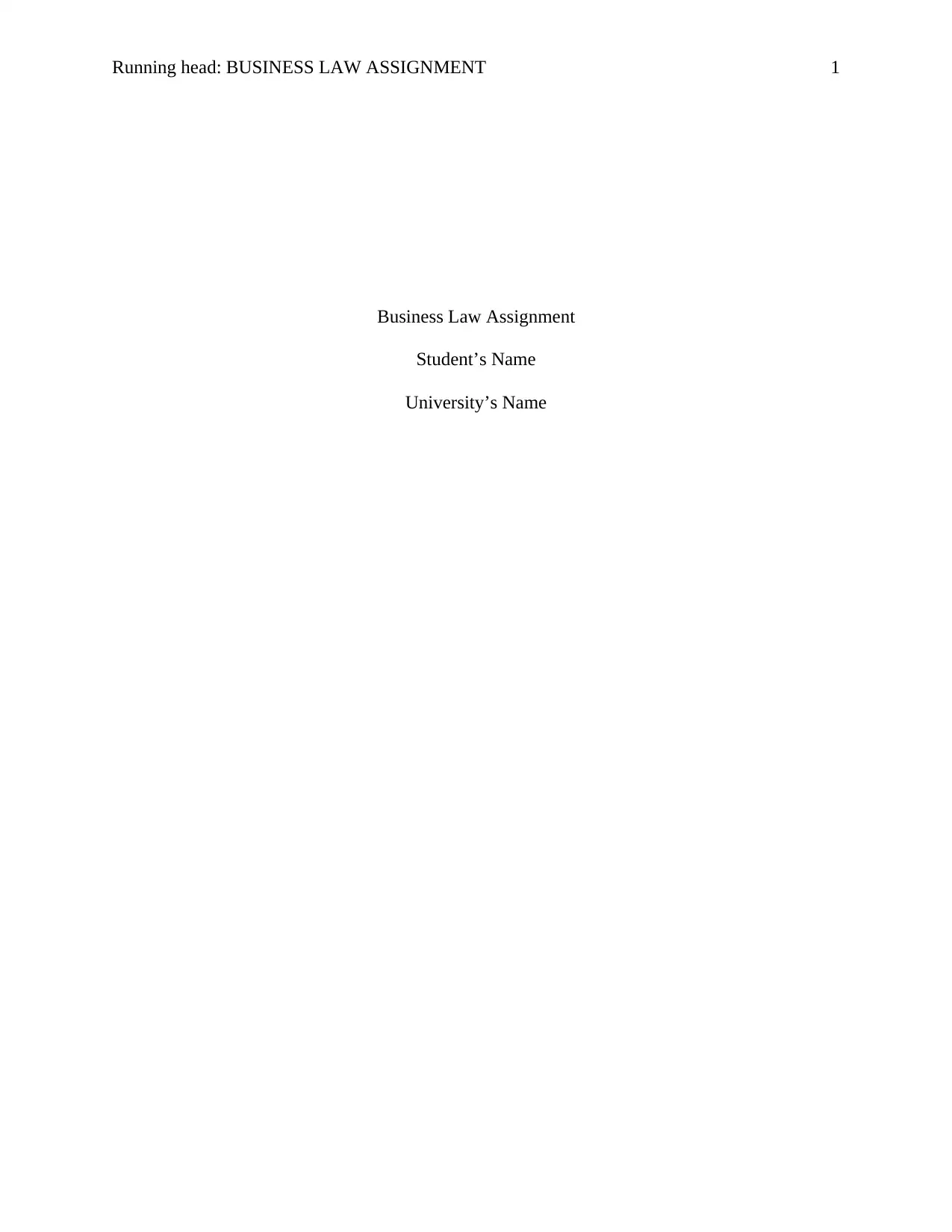
Running head: BUSINESS LAW ASSIGNMENT 1
Business Law Assignment
Student’s Name
University’s Name
Business Law Assignment
Student’s Name
University’s Name
Paraphrase This Document
Need a fresh take? Get an instant paraphrase of this document with our AI Paraphraser
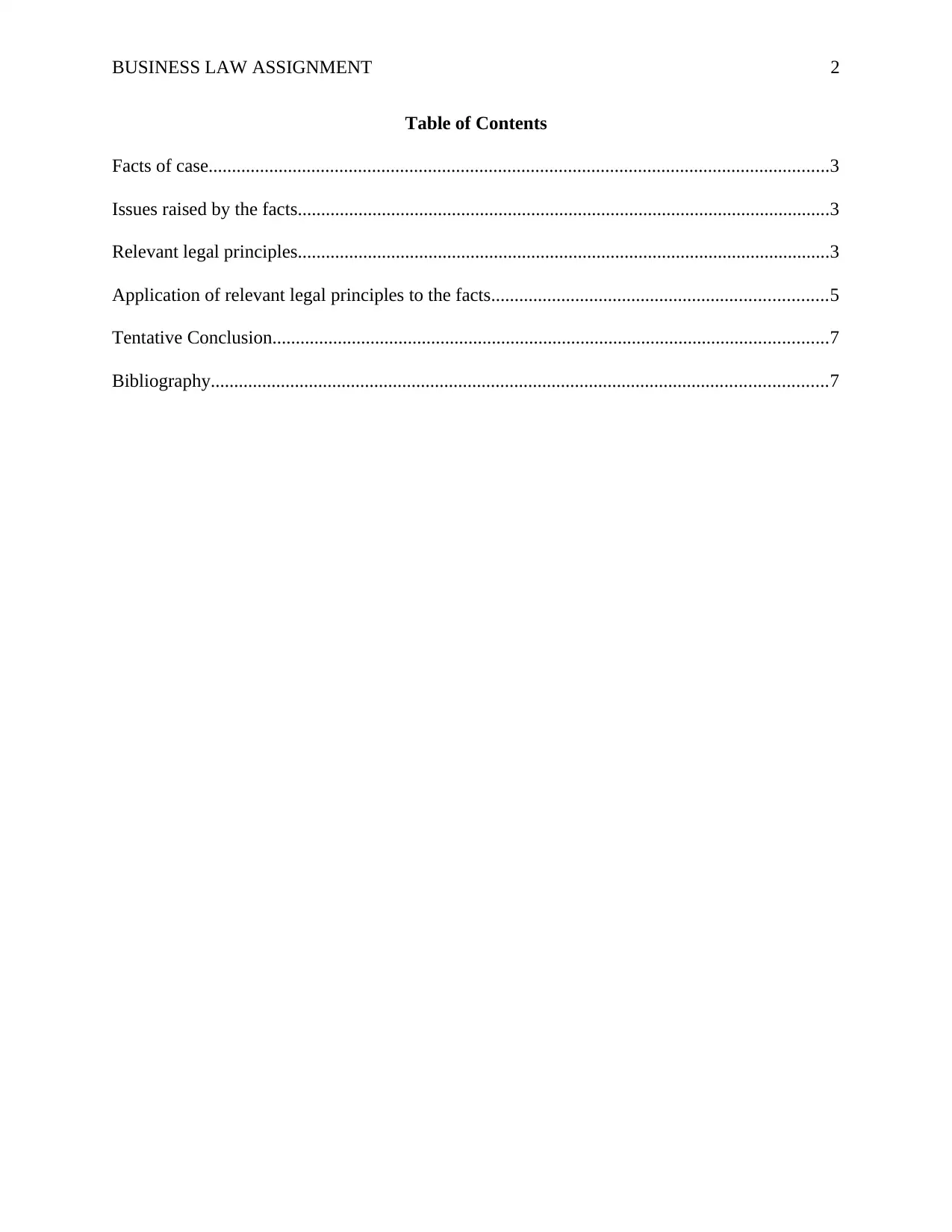
BUSINESS LAW ASSIGNMENT 2
Table of Contents
Facts of case.....................................................................................................................................3
Issues raised by the facts..................................................................................................................3
Relevant legal principles..................................................................................................................3
Application of relevant legal principles to the facts........................................................................5
Tentative Conclusion.......................................................................................................................7
Bibliography....................................................................................................................................7
Table of Contents
Facts of case.....................................................................................................................................3
Issues raised by the facts..................................................................................................................3
Relevant legal principles..................................................................................................................3
Application of relevant legal principles to the facts........................................................................5
Tentative Conclusion.......................................................................................................................7
Bibliography....................................................................................................................................7
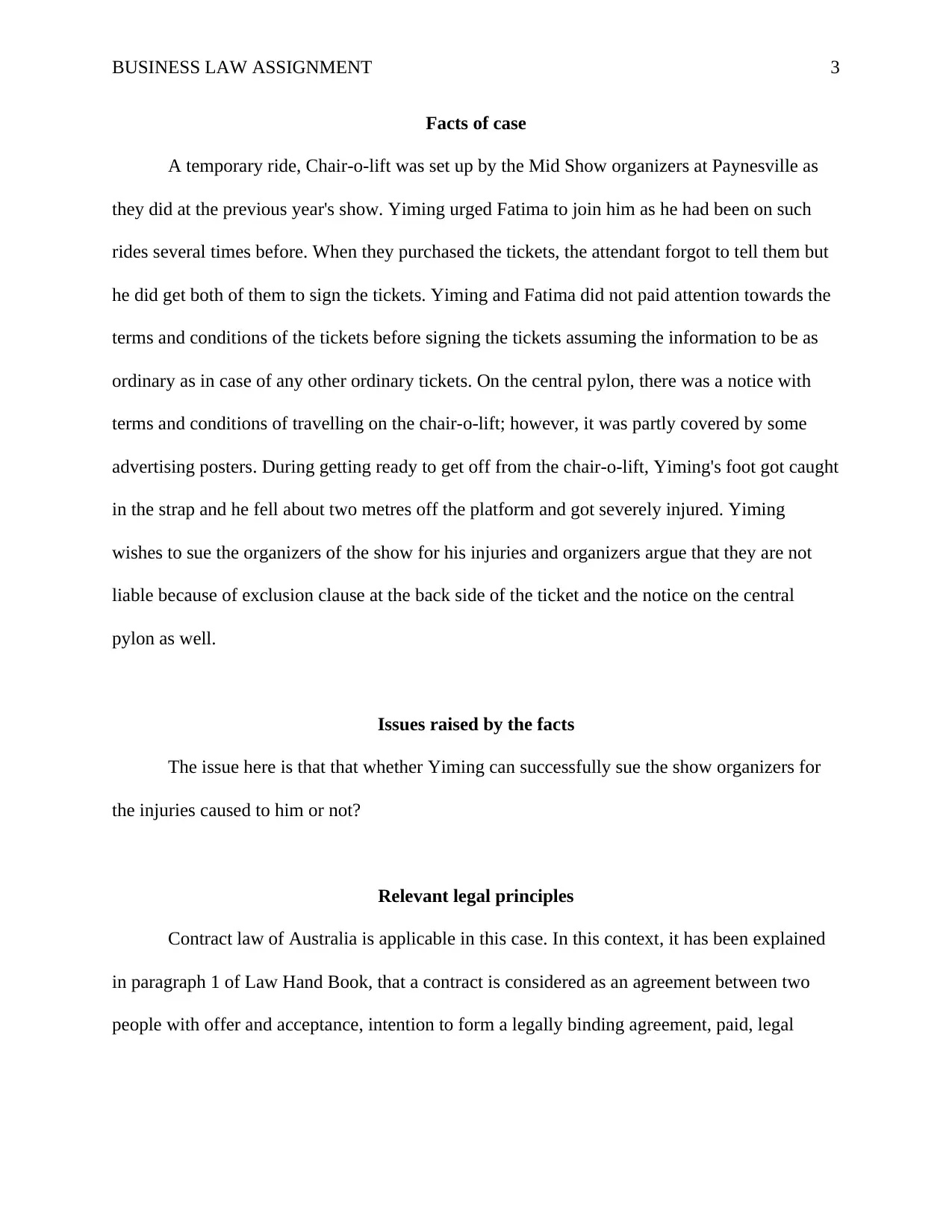
BUSINESS LAW ASSIGNMENT 3
Facts of case
A temporary ride, Chair-o-lift was set up by the Mid Show organizers at Paynesville as
they did at the previous year's show. Yiming urged Fatima to join him as he had been on such
rides several times before. When they purchased the tickets, the attendant forgot to tell them but
he did get both of them to sign the tickets. Yiming and Fatima did not paid attention towards the
terms and conditions of the tickets before signing the tickets assuming the information to be as
ordinary as in case of any other ordinary tickets. On the central pylon, there was a notice with
terms and conditions of travelling on the chair-o-lift; however, it was partly covered by some
advertising posters. During getting ready to get off from the chair-o-lift, Yiming's foot got caught
in the strap and he fell about two metres off the platform and got severely injured. Yiming
wishes to sue the organizers of the show for his injuries and organizers argue that they are not
liable because of exclusion clause at the back side of the ticket and the notice on the central
pylon as well.
Issues raised by the facts
The issue here is that that whether Yiming can successfully sue the show organizers for
the injuries caused to him or not?
Relevant legal principles
Contract law of Australia is applicable in this case. In this context, it has been explained
in paragraph 1 of Law Hand Book, that a contract is considered as an agreement between two
people with offer and acceptance, intention to form a legally binding agreement, paid, legal
Facts of case
A temporary ride, Chair-o-lift was set up by the Mid Show organizers at Paynesville as
they did at the previous year's show. Yiming urged Fatima to join him as he had been on such
rides several times before. When they purchased the tickets, the attendant forgot to tell them but
he did get both of them to sign the tickets. Yiming and Fatima did not paid attention towards the
terms and conditions of the tickets before signing the tickets assuming the information to be as
ordinary as in case of any other ordinary tickets. On the central pylon, there was a notice with
terms and conditions of travelling on the chair-o-lift; however, it was partly covered by some
advertising posters. During getting ready to get off from the chair-o-lift, Yiming's foot got caught
in the strap and he fell about two metres off the platform and got severely injured. Yiming
wishes to sue the organizers of the show for his injuries and organizers argue that they are not
liable because of exclusion clause at the back side of the ticket and the notice on the central
pylon as well.
Issues raised by the facts
The issue here is that that whether Yiming can successfully sue the show organizers for
the injuries caused to him or not?
Relevant legal principles
Contract law of Australia is applicable in this case. In this context, it has been explained
in paragraph 1 of Law Hand Book, that a contract is considered as an agreement between two
people with offer and acceptance, intention to form a legally binding agreement, paid, legal
⊘ This is a preview!⊘
Do you want full access?
Subscribe today to unlock all pages.

Trusted by 1+ million students worldwide
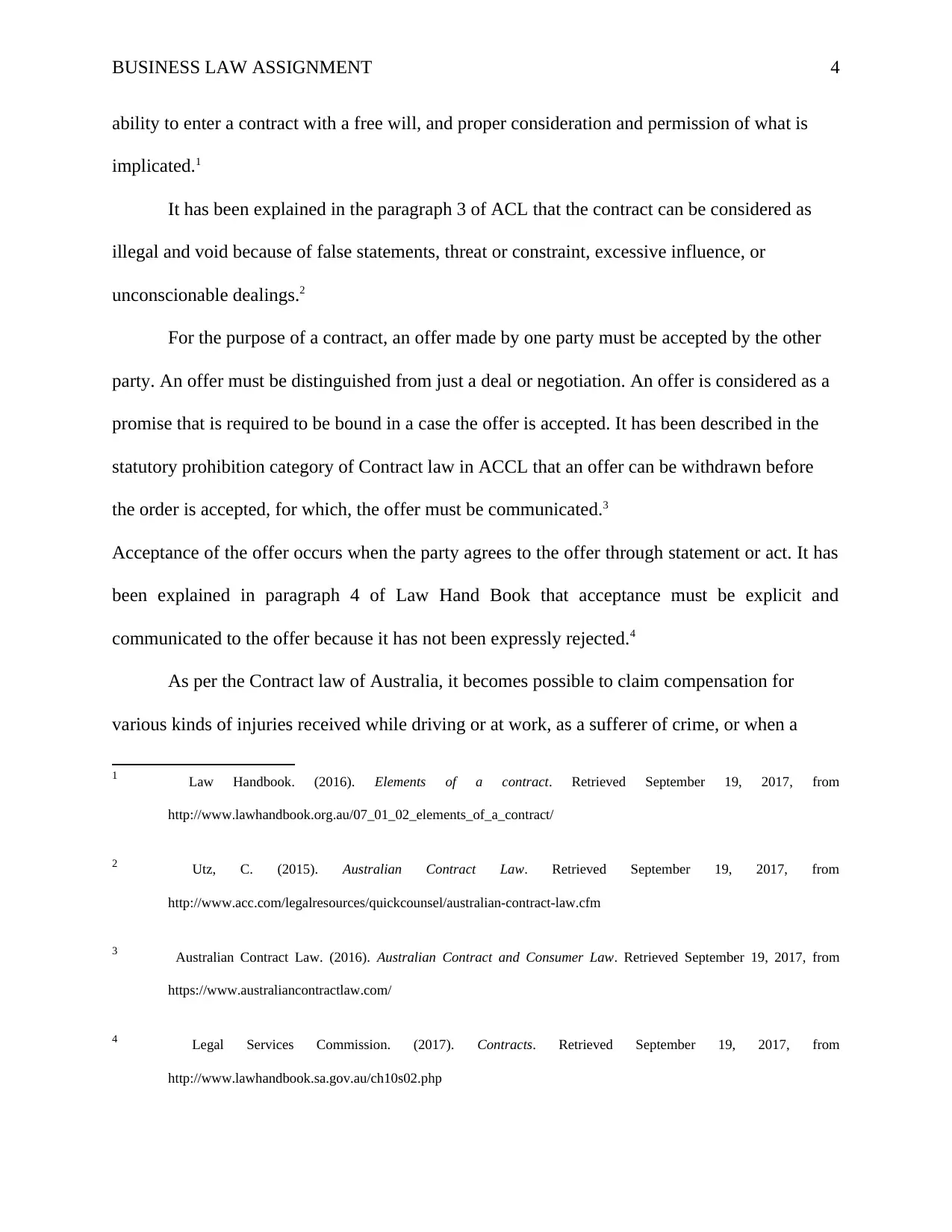
BUSINESS LAW ASSIGNMENT 4
ability to enter a contract with a free will, and proper consideration and permission of what is
implicated.1
It has been explained in the paragraph 3 of ACL that the contract can be considered as
illegal and void because of false statements, threat or constraint, excessive influence, or
unconscionable dealings.2
For the purpose of a contract, an offer made by one party must be accepted by the other
party. An offer must be distinguished from just a deal or negotiation. An offer is considered as a
promise that is required to be bound in a case the offer is accepted. It has been described in the
statutory prohibition category of Contract law in ACCL that an offer can be withdrawn before
the order is accepted, for which, the offer must be communicated.3
Acceptance of the offer occurs when the party agrees to the offer through statement or act. It has
been explained in paragraph 4 of Law Hand Book that acceptance must be explicit and
communicated to the offer because it has not been expressly rejected.4
As per the Contract law of Australia, it becomes possible to claim compensation for
various kinds of injuries received while driving or at work, as a sufferer of crime, or when a
1 Law Handbook. (2016). Elements of a contract. Retrieved September 19, 2017, from
http://www.lawhandbook.org.au/07_01_02_elements_of_a_contract/
2 Utz, C. (2015). Australian Contract Law. Retrieved September 19, 2017, from
http://www.acc.com/legalresources/quickcounsel/australian-contract-law.cfm
3 Australian Contract Law. (2016). Australian Contract and Consumer Law. Retrieved September 19, 2017, from
https://www.australiancontractlaw.com/
4 Legal Services Commission. (2017). Contracts. Retrieved September 19, 2017, from
http://www.lawhandbook.sa.gov.au/ch10s02.php
ability to enter a contract with a free will, and proper consideration and permission of what is
implicated.1
It has been explained in the paragraph 3 of ACL that the contract can be considered as
illegal and void because of false statements, threat or constraint, excessive influence, or
unconscionable dealings.2
For the purpose of a contract, an offer made by one party must be accepted by the other
party. An offer must be distinguished from just a deal or negotiation. An offer is considered as a
promise that is required to be bound in a case the offer is accepted. It has been described in the
statutory prohibition category of Contract law in ACCL that an offer can be withdrawn before
the order is accepted, for which, the offer must be communicated.3
Acceptance of the offer occurs when the party agrees to the offer through statement or act. It has
been explained in paragraph 4 of Law Hand Book that acceptance must be explicit and
communicated to the offer because it has not been expressly rejected.4
As per the Contract law of Australia, it becomes possible to claim compensation for
various kinds of injuries received while driving or at work, as a sufferer of crime, or when a
1 Law Handbook. (2016). Elements of a contract. Retrieved September 19, 2017, from
http://www.lawhandbook.org.au/07_01_02_elements_of_a_contract/
2 Utz, C. (2015). Australian Contract Law. Retrieved September 19, 2017, from
http://www.acc.com/legalresources/quickcounsel/australian-contract-law.cfm
3 Australian Contract Law. (2016). Australian Contract and Consumer Law. Retrieved September 19, 2017, from
https://www.australiancontractlaw.com/
4 Legal Services Commission. (2017). Contracts. Retrieved September 19, 2017, from
http://www.lawhandbook.sa.gov.au/ch10s02.php
Paraphrase This Document
Need a fresh take? Get an instant paraphrase of this document with our AI Paraphraser
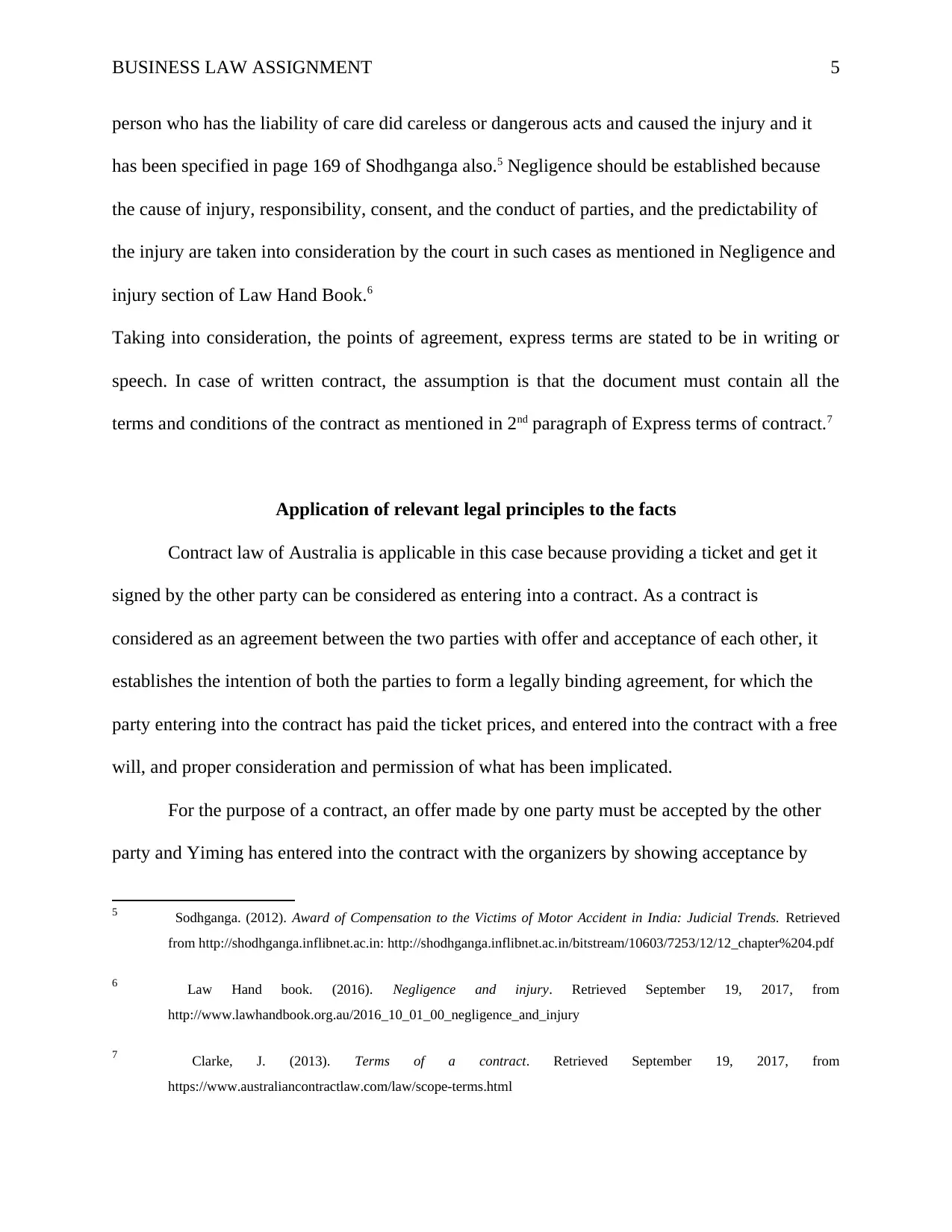
BUSINESS LAW ASSIGNMENT 5
person who has the liability of care did careless or dangerous acts and caused the injury and it
has been specified in page 169 of Shodhganga also.5 Negligence should be established because
the cause of injury, responsibility, consent, and the conduct of parties, and the predictability of
the injury are taken into consideration by the court in such cases as mentioned in Negligence and
injury section of Law Hand Book.6
Taking into consideration, the points of agreement, express terms are stated to be in writing or
speech. In case of written contract, the assumption is that the document must contain all the
terms and conditions of the contract as mentioned in 2nd paragraph of Express terms of contract.7
Application of relevant legal principles to the facts
Contract law of Australia is applicable in this case because providing a ticket and get it
signed by the other party can be considered as entering into a contract. As a contract is
considered as an agreement between the two parties with offer and acceptance of each other, it
establishes the intention of both the parties to form a legally binding agreement, for which the
party entering into the contract has paid the ticket prices, and entered into the contract with a free
will, and proper consideration and permission of what has been implicated.
For the purpose of a contract, an offer made by one party must be accepted by the other
party and Yiming has entered into the contract with the organizers by showing acceptance by
5 Sodhganga. (2012). Award of Compensation to the Victims of Motor Accident in India: Judicial Trends. Retrieved
from http://shodhganga.inflibnet.ac.in: http://shodhganga.inflibnet.ac.in/bitstream/10603/7253/12/12_chapter%204.pdf
6 Law Hand book. (2016). Negligence and injury. Retrieved September 19, 2017, from
http://www.lawhandbook.org.au/2016_10_01_00_negligence_and_injury
7 Clarke, J. (2013). Terms of a contract. Retrieved September 19, 2017, from
https://www.australiancontractlaw.com/law/scope-terms.html
person who has the liability of care did careless or dangerous acts and caused the injury and it
has been specified in page 169 of Shodhganga also.5 Negligence should be established because
the cause of injury, responsibility, consent, and the conduct of parties, and the predictability of
the injury are taken into consideration by the court in such cases as mentioned in Negligence and
injury section of Law Hand Book.6
Taking into consideration, the points of agreement, express terms are stated to be in writing or
speech. In case of written contract, the assumption is that the document must contain all the
terms and conditions of the contract as mentioned in 2nd paragraph of Express terms of contract.7
Application of relevant legal principles to the facts
Contract law of Australia is applicable in this case because providing a ticket and get it
signed by the other party can be considered as entering into a contract. As a contract is
considered as an agreement between the two parties with offer and acceptance of each other, it
establishes the intention of both the parties to form a legally binding agreement, for which the
party entering into the contract has paid the ticket prices, and entered into the contract with a free
will, and proper consideration and permission of what has been implicated.
For the purpose of a contract, an offer made by one party must be accepted by the other
party and Yiming has entered into the contract with the organizers by showing acceptance by
5 Sodhganga. (2012). Award of Compensation to the Victims of Motor Accident in India: Judicial Trends. Retrieved
from http://shodhganga.inflibnet.ac.in: http://shodhganga.inflibnet.ac.in/bitstream/10603/7253/12/12_chapter%204.pdf
6 Law Hand book. (2016). Negligence and injury. Retrieved September 19, 2017, from
http://www.lawhandbook.org.au/2016_10_01_00_negligence_and_injury
7 Clarke, J. (2013). Terms of a contract. Retrieved September 19, 2017, from
https://www.australiancontractlaw.com/law/scope-terms.html
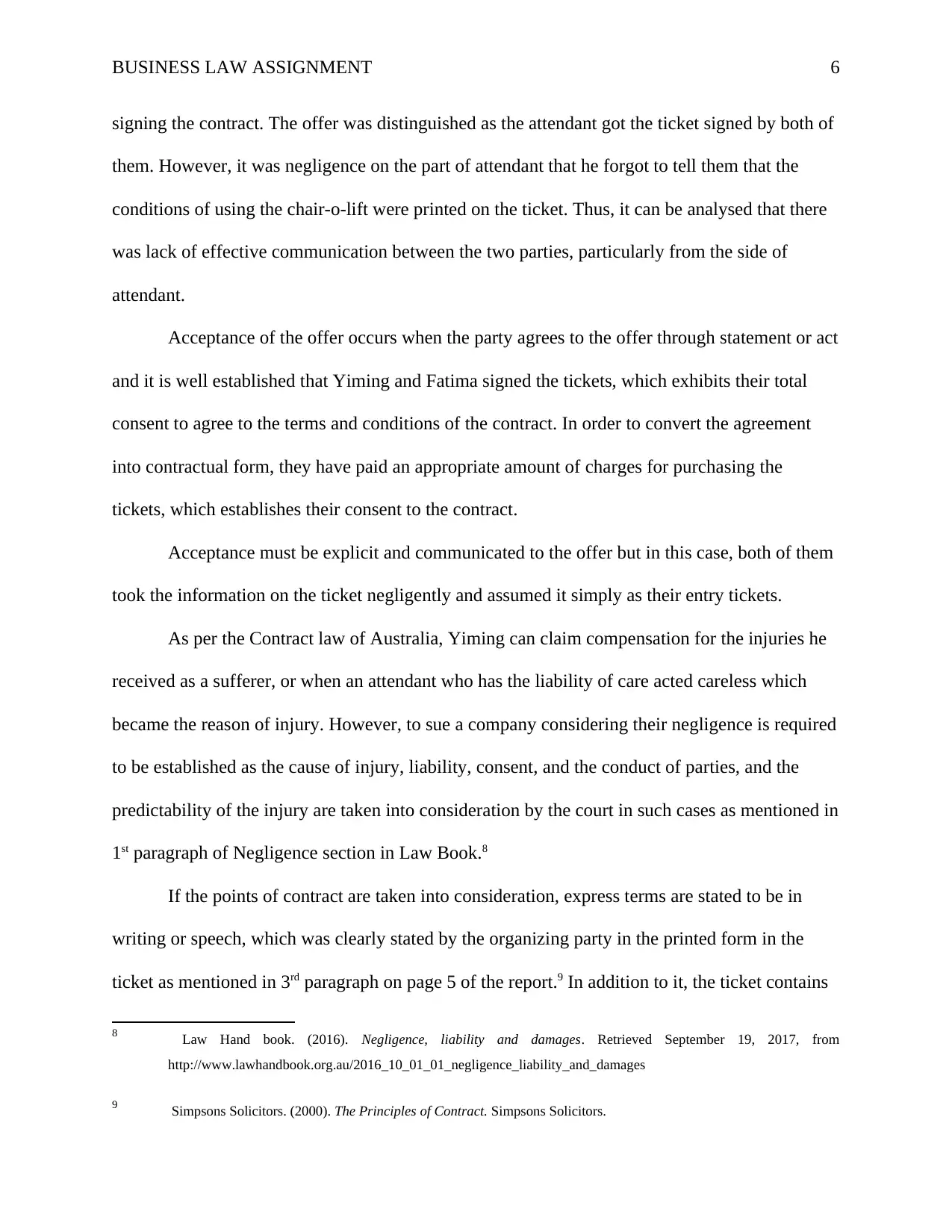
BUSINESS LAW ASSIGNMENT 6
signing the contract. The offer was distinguished as the attendant got the ticket signed by both of
them. However, it was negligence on the part of attendant that he forgot to tell them that the
conditions of using the chair-o-lift were printed on the ticket. Thus, it can be analysed that there
was lack of effective communication between the two parties, particularly from the side of
attendant.
Acceptance of the offer occurs when the party agrees to the offer through statement or act
and it is well established that Yiming and Fatima signed the tickets, which exhibits their total
consent to agree to the terms and conditions of the contract. In order to convert the agreement
into contractual form, they have paid an appropriate amount of charges for purchasing the
tickets, which establishes their consent to the contract.
Acceptance must be explicit and communicated to the offer but in this case, both of them
took the information on the ticket negligently and assumed it simply as their entry tickets.
As per the Contract law of Australia, Yiming can claim compensation for the injuries he
received as a sufferer, or when an attendant who has the liability of care acted careless which
became the reason of injury. However, to sue a company considering their negligence is required
to be established as the cause of injury, liability, consent, and the conduct of parties, and the
predictability of the injury are taken into consideration by the court in such cases as mentioned in
1st paragraph of Negligence section in Law Book.8
If the points of contract are taken into consideration, express terms are stated to be in
writing or speech, which was clearly stated by the organizing party in the printed form in the
ticket as mentioned in 3rd paragraph on page 5 of the report.9 In addition to it, the ticket contains
8 Law Hand book. (2016). Negligence, liability and damages. Retrieved September 19, 2017, from
http://www.lawhandbook.org.au/2016_10_01_01_negligence_liability_and_damages
9 Simpsons Solicitors. (2000). The Principles of Contract. Simpsons Solicitors.
signing the contract. The offer was distinguished as the attendant got the ticket signed by both of
them. However, it was negligence on the part of attendant that he forgot to tell them that the
conditions of using the chair-o-lift were printed on the ticket. Thus, it can be analysed that there
was lack of effective communication between the two parties, particularly from the side of
attendant.
Acceptance of the offer occurs when the party agrees to the offer through statement or act
and it is well established that Yiming and Fatima signed the tickets, which exhibits their total
consent to agree to the terms and conditions of the contract. In order to convert the agreement
into contractual form, they have paid an appropriate amount of charges for purchasing the
tickets, which establishes their consent to the contract.
Acceptance must be explicit and communicated to the offer but in this case, both of them
took the information on the ticket negligently and assumed it simply as their entry tickets.
As per the Contract law of Australia, Yiming can claim compensation for the injuries he
received as a sufferer, or when an attendant who has the liability of care acted careless which
became the reason of injury. However, to sue a company considering their negligence is required
to be established as the cause of injury, liability, consent, and the conduct of parties, and the
predictability of the injury are taken into consideration by the court in such cases as mentioned in
1st paragraph of Negligence section in Law Book.8
If the points of contract are taken into consideration, express terms are stated to be in
writing or speech, which was clearly stated by the organizing party in the printed form in the
ticket as mentioned in 3rd paragraph on page 5 of the report.9 In addition to it, the ticket contains
8 Law Hand book. (2016). Negligence, liability and damages. Retrieved September 19, 2017, from
http://www.lawhandbook.org.au/2016_10_01_01_negligence_liability_and_damages
9 Simpsons Solicitors. (2000). The Principles of Contract. Simpsons Solicitors.
⊘ This is a preview!⊘
Do you want full access?
Subscribe today to unlock all pages.

Trusted by 1+ million students worldwide
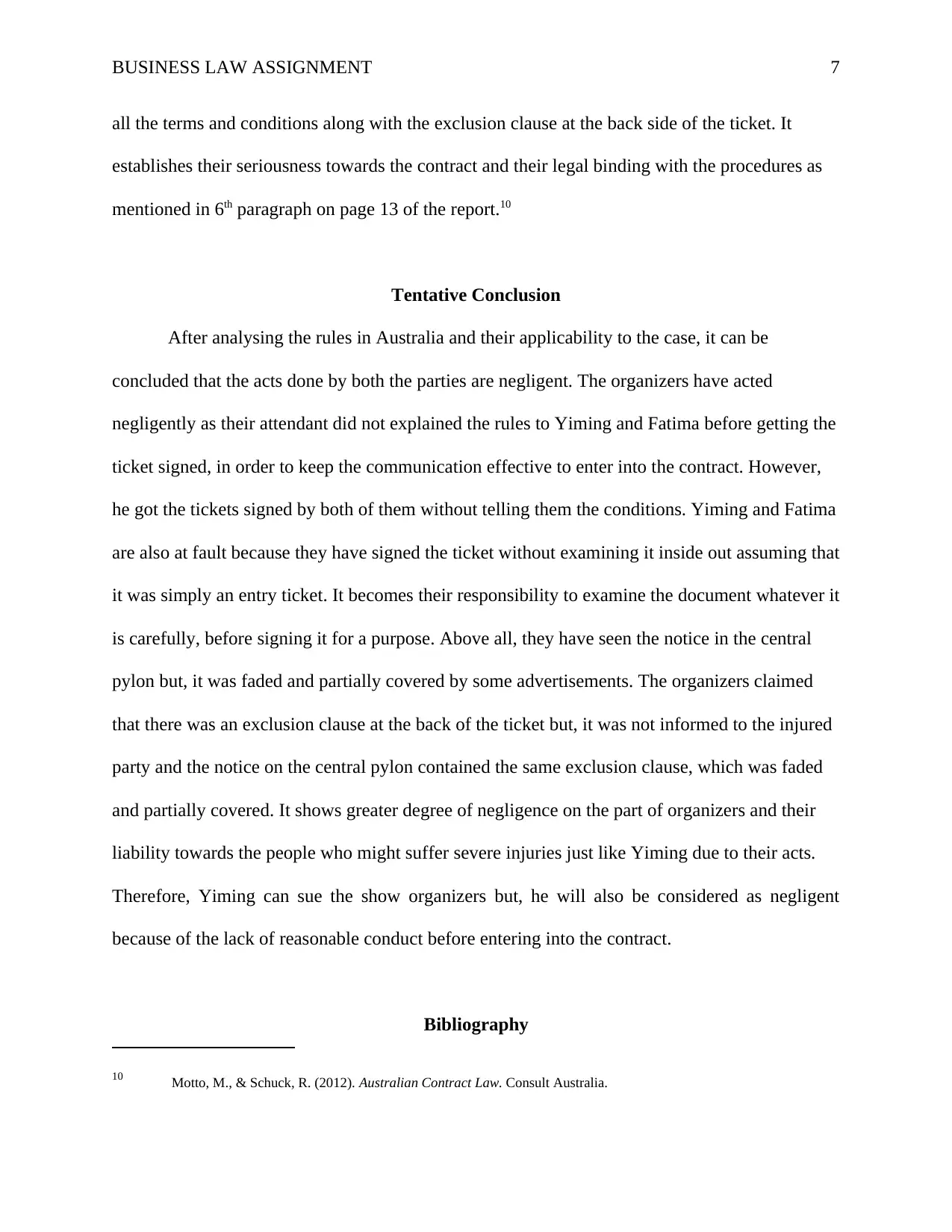
BUSINESS LAW ASSIGNMENT 7
all the terms and conditions along with the exclusion clause at the back side of the ticket. It
establishes their seriousness towards the contract and their legal binding with the procedures as
mentioned in 6th paragraph on page 13 of the report.10
Tentative Conclusion
After analysing the rules in Australia and their applicability to the case, it can be
concluded that the acts done by both the parties are negligent. The organizers have acted
negligently as their attendant did not explained the rules to Yiming and Fatima before getting the
ticket signed, in order to keep the communication effective to enter into the contract. However,
he got the tickets signed by both of them without telling them the conditions. Yiming and Fatima
are also at fault because they have signed the ticket without examining it inside out assuming that
it was simply an entry ticket. It becomes their responsibility to examine the document whatever it
is carefully, before signing it for a purpose. Above all, they have seen the notice in the central
pylon but, it was faded and partially covered by some advertisements. The organizers claimed
that there was an exclusion clause at the back of the ticket but, it was not informed to the injured
party and the notice on the central pylon contained the same exclusion clause, which was faded
and partially covered. It shows greater degree of negligence on the part of organizers and their
liability towards the people who might suffer severe injuries just like Yiming due to their acts.
Therefore, Yiming can sue the show organizers but, he will also be considered as negligent
because of the lack of reasonable conduct before entering into the contract.
Bibliography
10 Motto, M., & Schuck, R. (2012). Australian Contract Law. Consult Australia.
all the terms and conditions along with the exclusion clause at the back side of the ticket. It
establishes their seriousness towards the contract and their legal binding with the procedures as
mentioned in 6th paragraph on page 13 of the report.10
Tentative Conclusion
After analysing the rules in Australia and their applicability to the case, it can be
concluded that the acts done by both the parties are negligent. The organizers have acted
negligently as their attendant did not explained the rules to Yiming and Fatima before getting the
ticket signed, in order to keep the communication effective to enter into the contract. However,
he got the tickets signed by both of them without telling them the conditions. Yiming and Fatima
are also at fault because they have signed the ticket without examining it inside out assuming that
it was simply an entry ticket. It becomes their responsibility to examine the document whatever it
is carefully, before signing it for a purpose. Above all, they have seen the notice in the central
pylon but, it was faded and partially covered by some advertisements. The organizers claimed
that there was an exclusion clause at the back of the ticket but, it was not informed to the injured
party and the notice on the central pylon contained the same exclusion clause, which was faded
and partially covered. It shows greater degree of negligence on the part of organizers and their
liability towards the people who might suffer severe injuries just like Yiming due to their acts.
Therefore, Yiming can sue the show organizers but, he will also be considered as negligent
because of the lack of reasonable conduct before entering into the contract.
Bibliography
10 Motto, M., & Schuck, R. (2012). Australian Contract Law. Consult Australia.
Paraphrase This Document
Need a fresh take? Get an instant paraphrase of this document with our AI Paraphraser
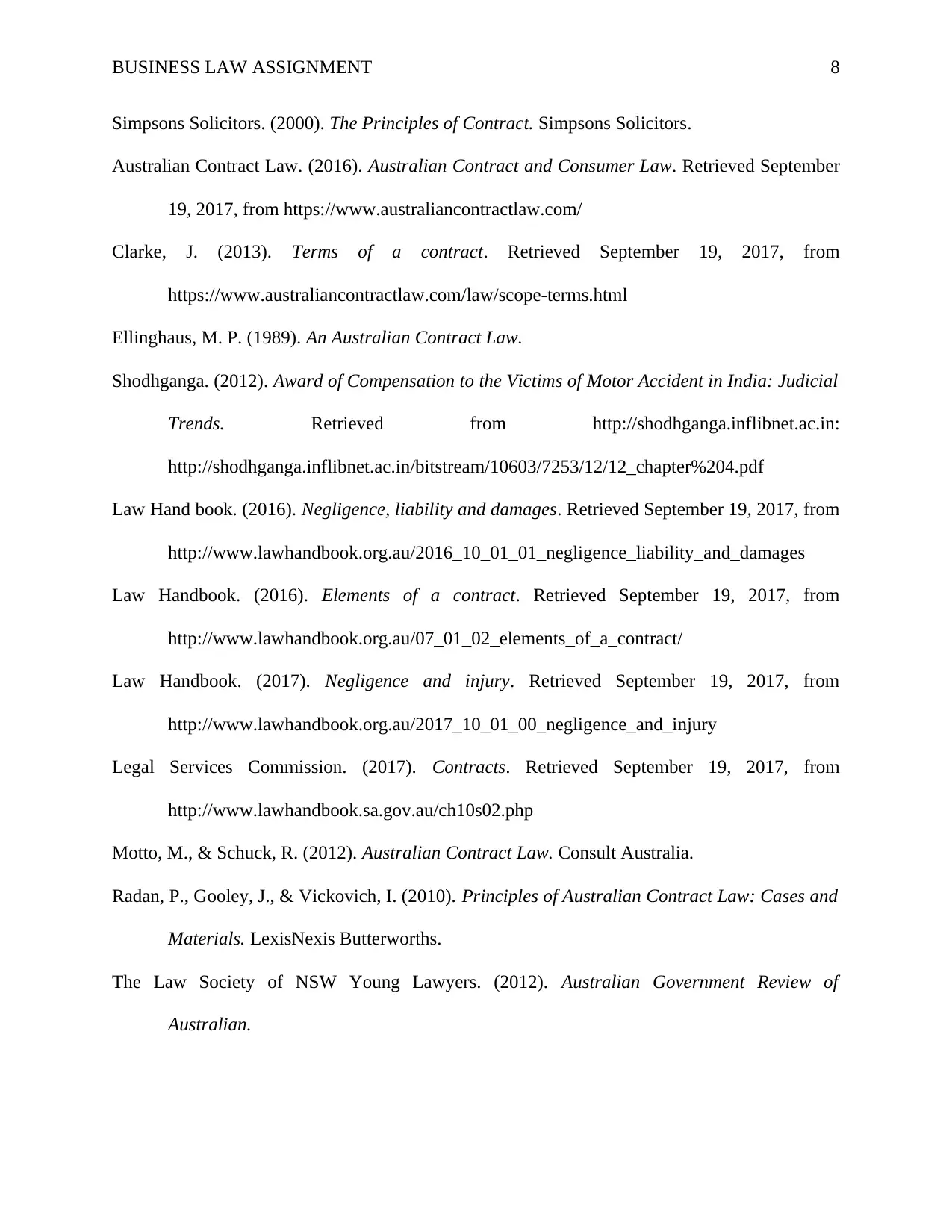
BUSINESS LAW ASSIGNMENT 8
Simpsons Solicitors. (2000). The Principles of Contract. Simpsons Solicitors.
Australian Contract Law. (2016). Australian Contract and Consumer Law. Retrieved September
19, 2017, from https://www.australiancontractlaw.com/
Clarke, J. (2013). Terms of a contract. Retrieved September 19, 2017, from
https://www.australiancontractlaw.com/law/scope-terms.html
Ellinghaus, M. P. (1989). An Australian Contract Law.
Shodhganga. (2012). Award of Compensation to the Victims of Motor Accident in India: Judicial
Trends. Retrieved from http://shodhganga.inflibnet.ac.in:
http://shodhganga.inflibnet.ac.in/bitstream/10603/7253/12/12_chapter%204.pdf
Law Hand book. (2016). Negligence, liability and damages. Retrieved September 19, 2017, from
http://www.lawhandbook.org.au/2016_10_01_01_negligence_liability_and_damages
Law Handbook. (2016). Elements of a contract. Retrieved September 19, 2017, from
http://www.lawhandbook.org.au/07_01_02_elements_of_a_contract/
Law Handbook. (2017). Negligence and injury. Retrieved September 19, 2017, from
http://www.lawhandbook.org.au/2017_10_01_00_negligence_and_injury
Legal Services Commission. (2017). Contracts. Retrieved September 19, 2017, from
http://www.lawhandbook.sa.gov.au/ch10s02.php
Motto, M., & Schuck, R. (2012). Australian Contract Law. Consult Australia.
Radan, P., Gooley, J., & Vickovich, I. (2010). Principles of Australian Contract Law: Cases and
Materials. LexisNexis Butterworths.
The Law Society of NSW Young Lawyers. (2012). Australian Government Review of
Australian.
Simpsons Solicitors. (2000). The Principles of Contract. Simpsons Solicitors.
Australian Contract Law. (2016). Australian Contract and Consumer Law. Retrieved September
19, 2017, from https://www.australiancontractlaw.com/
Clarke, J. (2013). Terms of a contract. Retrieved September 19, 2017, from
https://www.australiancontractlaw.com/law/scope-terms.html
Ellinghaus, M. P. (1989). An Australian Contract Law.
Shodhganga. (2012). Award of Compensation to the Victims of Motor Accident in India: Judicial
Trends. Retrieved from http://shodhganga.inflibnet.ac.in:
http://shodhganga.inflibnet.ac.in/bitstream/10603/7253/12/12_chapter%204.pdf
Law Hand book. (2016). Negligence, liability and damages. Retrieved September 19, 2017, from
http://www.lawhandbook.org.au/2016_10_01_01_negligence_liability_and_damages
Law Handbook. (2016). Elements of a contract. Retrieved September 19, 2017, from
http://www.lawhandbook.org.au/07_01_02_elements_of_a_contract/
Law Handbook. (2017). Negligence and injury. Retrieved September 19, 2017, from
http://www.lawhandbook.org.au/2017_10_01_00_negligence_and_injury
Legal Services Commission. (2017). Contracts. Retrieved September 19, 2017, from
http://www.lawhandbook.sa.gov.au/ch10s02.php
Motto, M., & Schuck, R. (2012). Australian Contract Law. Consult Australia.
Radan, P., Gooley, J., & Vickovich, I. (2010). Principles of Australian Contract Law: Cases and
Materials. LexisNexis Butterworths.
The Law Society of NSW Young Lawyers. (2012). Australian Government Review of
Australian.
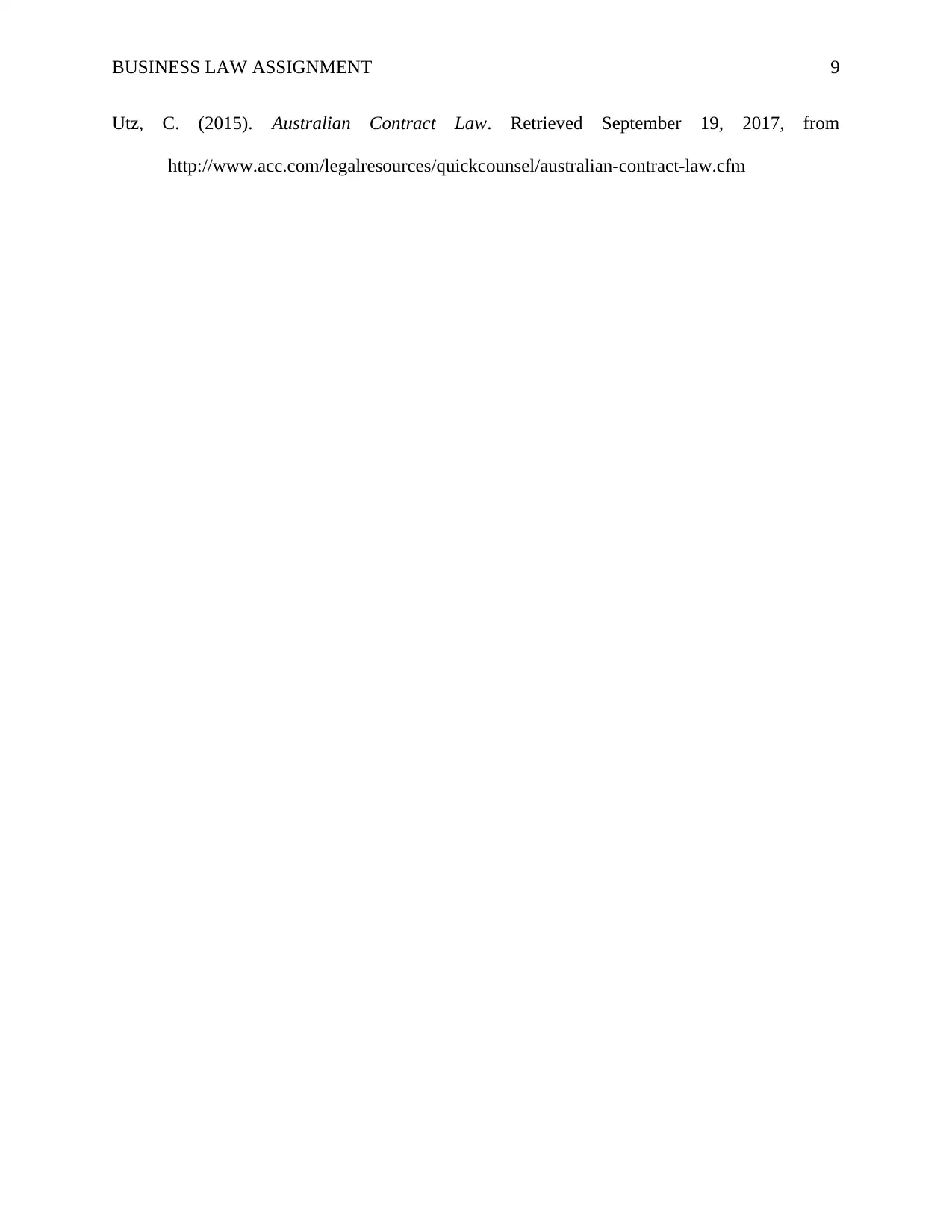
BUSINESS LAW ASSIGNMENT 9
Utz, C. (2015). Australian Contract Law. Retrieved September 19, 2017, from
http://www.acc.com/legalresources/quickcounsel/australian-contract-law.cfm
Utz, C. (2015). Australian Contract Law. Retrieved September 19, 2017, from
http://www.acc.com/legalresources/quickcounsel/australian-contract-law.cfm
⊘ This is a preview!⊘
Do you want full access?
Subscribe today to unlock all pages.

Trusted by 1+ million students worldwide
1 out of 9
Related Documents
Your All-in-One AI-Powered Toolkit for Academic Success.
+13062052269
info@desklib.com
Available 24*7 on WhatsApp / Email
![[object Object]](/_next/static/media/star-bottom.7253800d.svg)
Unlock your academic potential
Copyright © 2020–2025 A2Z Services. All Rights Reserved. Developed and managed by ZUCOL.





